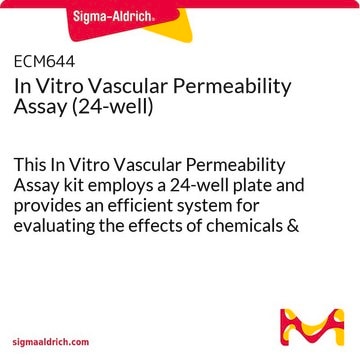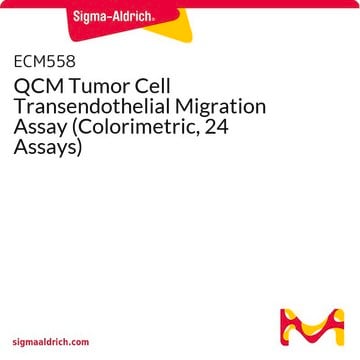ECM554
QCM ECMatrix Cell Invasion Assay, 24-well (8 µm), fluorimetric
The Cell Invasion Assay Kit kuses a 24 well plate with 8 um pores, which is ideal for evaluation of invasive tumor cells.
Synonym(s):
Cell invasion assessment kit
Sign Into View Organizational & Contract Pricing
All Photos(1)
About This Item
UNSPSC Code:
12352207
eCl@ss:
32161000
NACRES:
NA.84
Recommended Products
Quality Level
species reactivity
vertebrates
manufacturer/tradename
Chemicon®
QCM
technique(s)
cell based assay: suitable
detection method
fluorometric
shipped in
wet ice
Application
Research Category
Cell Structure
Cell Structure
The CHEMICON® Cell Invasion Assay Kit is ideal for evaluation of invasive tumor cells. Each CHEMICON Cell Invasion Assay Kit contains sufficient reagents for the evaluation of 24 samples. The quantitative nature of this assay is especially useful for screening of pharmacological agents.
The CHEMICON Cell Invasion Assay Kit is intended for research use only; not for diagnostic or therapeutic applications.
The CHEMICON Cell Invasion Assay Kit is intended for research use only; not for diagnostic or therapeutic applications.
The Cell Invasion Assay Kit kuses a 24 well plate with 8 um pores, which is ideal for evaluation of invasive tumor cells.
Packaging
24 assays
Components
Sterile 24-well Cell Invasion Plate Assembly: (Part No. 70019) Two 24-well plates with 12 ECMatrixTM-coated inserts per plate (24 coated inserts total/kit for 24 assays).
Cell Detachment Solution: (Part Number 90131) One bottle - 16 mL.
4X Cell Lysis Buffer: (Part Number 90130) One bottle - 16 mL.
CyQuant GR Dye 1: (Part Number 90132) One vial - 75 mL
Forceps: (Part Number 10203) One each.
Cell Detachment Solution: (Part Number 90131) One bottle - 16 mL.
4X Cell Lysis Buffer: (Part Number 90130) One bottle - 16 mL.
CyQuant GR Dye 1: (Part Number 90132) One vial - 75 mL
Forceps: (Part Number 10203) One each.
Storage and Stability
Store kit materials at 2-8°C for up to their expiration date. Do not freeze.
Legal Information
CHEMICON is a registered trademark of Merck KGaA, Darmstadt, Germany
Disclaimer
Unless otherwise stated in our catalog or other company documentation accompanying the product(s), our products are intended for research use only and are not to be used for any other purpose, which includes but is not limited to, unauthorized commercial uses, in vitro diagnostic uses, ex vivo or in vivo therapeutic uses or any type of consumption or application to humans or animals.
Signal Word
Danger
Hazard Statements
Precautionary Statements
Hazard Classifications
Aquatic Acute 1 - Aquatic Chronic 2 - Eye Dam. 1
Storage Class Code
10 - Combustible liquids
WGK
WGK 2
Certificates of Analysis (COA)
Search for Certificates of Analysis (COA) by entering the products Lot/Batch Number. Lot and Batch Numbers can be found on a product’s label following the words ‘Lot’ or ‘Batch’.
Already Own This Product?
Find documentation for the products that you have recently purchased in the Document Library.
Kate Lawrenson et al.
Carcinogenesis, 32(10), 1540-1549 (2011-08-24)
The biology underlying early-stage epithelial ovarian cancer (EOC) development is poorly understood. Identifying biomarkers associated with early-stage disease could have a significant impact on reducing mortality. Here, we describe establishment of a three-dimensional (3D) in vitro genetic model of EOC
Bei Wang et al.
Journal of hepatology, 50(3), 528-537 (2009-01-22)
Hepatocellular carcinoma (HCC) is one of the leading causes of cancer-related death worldwide with poor prognosis associated with tumor invasion and metastasis. The tumor suppressor p53 plays critical roles in tumor development, but there is increasing evidence for its involvement
Roberta M Moretti et al.
International journal of oncology, 33(2), 405-413 (2008-07-19)
Cutaneous melanoma represents the leading cause of skin cancer deaths. The prognosis of highly aggressive, metastatic melanoma is still very poor, due to the resistance of the disseminated tumor to existing therapies. The clarification of the molecular mechanisms regulating melanoma
Xujun He et al.
Oncotarget, 8(1), 1247-1261 (2016-12-03)
Increased expression of HOXB7 has been reported to correlate with the progression in many cancers. However, the specific mechanism by which it promotes the evolution of gastric cancer (GC) is poorly understood.In this study, we sought to investigate the role
Adam S Adler et al.
Nature genetics, 38(4), 421-430 (2006-03-07)
Gene expression signatures encompassing dozens to hundreds of genes have been associated with many important parameters of cancer, but mechanisms of their control are largely unknown. Here we present a method based on genetic linkage that can prospectively identify functional
Our team of scientists has experience in all areas of research including Life Science, Material Science, Chemical Synthesis, Chromatography, Analytical and many others.
Contact Technical Service









